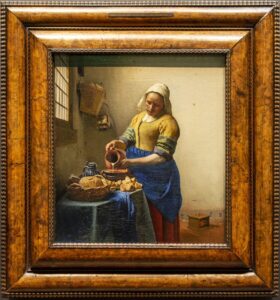
Considered an inflation hedge and alternative to volatility in equity markets, art has long been an investment favored by the wealthy. However, in today’s turbulent economy, it is now accessible to average investors.
Although the stock market closed the first quarter this year up, the OPEC+ announcement that it will cut oil production in May sent it tumbling Monday morning. After recovering, the markets were again rocked today by a report of a slowing job market and recession fears.
At the same time, the yield on the 10-year Treasury Note dropped to 3.283 percent by midday.
The only bright spots were a rise in healthcare stocks and gold futures. Even oil had retreated from its Monday high.
Art Counters Market Swings
Because art is not tied to the stock market, it can perform as a counterweight to turbulent equities. In addition, it can function as an inflation hedge.
Investing in individual art objects is typically a buy-and-hold proposition. The idea is that you park your money in a painting, sculpture, etc. for a period of time. During that time, the artwork appreciates. Subsequently, you sell it for a profit.
An example of the boost an auction can give to a work of art is the record set by a Banksy piece sold at Christie’s in 2021. Originally valued at $1.4 to $2 million, Game Changer was sold for $23 million.
Though he now has some gallery showings, Banksy maintains his standing as an anonymous street artist. He often stencils his work on the sides of buildings, bridges, walls, and other outdoor spaces clandestinely. Dealers and collectors have been known to buy and replace the surfaces on which the paintings are made. So, if you own a building someone tags, you might want to call an art appraiser before painting over it.
Performance
Worldwide, art is estimated to have a value of over $1.7 trillion, according to Deloitte. In addition, sales volume grew last year by three percent to $67.8 billion, according to the 2023 Art Basil and UBS market report.
In addition, returns on art investments have done well for decades. A Citi Global report shows an estimated 8.3 percent annual return on investment in art from 1985 to 2020.
Knowing Your Stuff
Purchasing individual art pieces for investment requires a lot of knowledge. That one art appreciation class you slept through will not give you enough background. Many investors who have made the greatest profits in art have done so by finding an unknown artist and promoting his or her work.
Still, others who have made fortunes in art dealing have had substantial backing from other investors or started with a fortune of their own. Many of these types invest years in learning about art and artists or hire appraisers who have paid their dues.
One of the biggest risks in art investing is forgery.
Even Experts Get Fooled
One of the most disruptive forgery cases came out of World War II.
If you read history or saw the 2014 movie “The Monuments Men” you know the Nazis stole a lot of great art. One of the biggest art collectors/thieves was Hitler’s number two – Hermann Goering.
During the later stages of the war, Goering swapped 200 Dutch paintings he stole earlier for a single masterpiece Women Taken in Adultery by Johannes Vermeer. Such a transaction was considered collaborating with the enemy – a crime that could have been punishable by death. As a result, the dealer who sold the painting to Goering, Han van Meegeren, was arrested after the war.
However, van Meegeren beat the wrap. His defense was that the painting he sold Goering was a forgery he created. After a two-year trial in which van Meegeren demonstrated his technique by painting a forgery in the courtroom, the collaborating charge was dropped. However, it was replaced with a forgery charge. As a result, a relieved van Meegeren served a year in jail and confessed to several other forgeries.
This episode prompted a stunned art world to redouble its authentication efforts.
Beating Time and Money
The path to owning expensive art is barred by the high cost and the time to develop expertise. However, there are avenues that offer art investments at a lower price.
One way to own art for profit on a budget is through fractional investing. In this model, you and other investors own shares of work. The art is held until it appreciates and is then sold. At that time, you and the other shareholders split the proceeds.
Masterworks is one of the pioneers in fractional art investing. It researches artists and the art market to find pieces with appreciation potential. It then files an offering circular with the Securities and Exchange Commission to offer regulated investing.
The hold period Masterworks aims for is three to 10 years. However, it maintains a trading market to buy shares if you want to get out early. The drawback is that the market may not have the liquidity to buy your shares at a good price.
Another platform offering fractional investing is Otis. In addition to art, Otis provides fractional investing in collectibles, and NFTs, among others. Investors trade shares in their fractional investments. In addition, buyouts may be offered. Recently Otis itself was acquired by registered broker-dealer Public.com.
Funds
Various mutual funds and ETFs may include similar investments, but none are focused exclusively on art.
Nevertheless, Yieldstreet, which deals in a variety of alternative investments, produces art equity funds. These funds typically cobble together 10 to 20 works that are held until they can be sold for a profit.
Yieldstreet also deals in art investments only open to accredited investors. To qualify as an accredited investor, you must have Over $ 1 million in net worth and an income of $200,000 for single people or $300,000 for a married couple.
Conclusion
Despite trading platforms, art is an illiquid investment. It is best suited for individuals who can wait years for their investment to appreciate before selling.
In addition, like any investment, you should have a good understanding of how it works.
However, art has the potential to hold its value and even appreciate without being subject to stock and bond market swings.
Read More:
- Tips for Preparing and Filing Your Small Business Taxes Correctly
- Effective Ways to Save Money on Business Taxes
- Should You Be Paying to File Your Taxes?
Come back to what you love! Dollardig.com is the most reliable cashback site on the web. Just sign up, click, shop, and get full cash back!

Max K. Erkiletian began writing for newspapers while still in high school. He went on to become an award-winning journalist and co-founder of the print magazine Free Bird. He has written for a wide range of regional and national publications as well as many on-line publications. That has afforded him the opportunity to interview a variety of prominent figures from former Chairman of the Federal Reserve Bank Paul Volker to Blues musicians Muddy Waters and B. B. King. Max lives in Springfield, MO with his wife Karen and their cat – Pudge. He spends as much time as possible with his kids, grandchildren, and great-grandchildren.
Comments